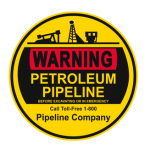One of the possible risks you face, whether at home or at work, is from a pipeline leak. A good emergency preparedness plan reminds you to find out where pipelines are located, what they carry, and how to respond if there is an emergency.
Step One: Look for nearby pipelines.

Have you seen this sign?
Find local pipelines by watching for pipeline signs as you go about your daily business! They are typically posted at major intersections, railroad and water crossings, and at property boundaries. The sign shown here is only a sample; a real sign would give more information about the kind of material being carried by the pipeline – for example, “petroleum,” “high pressure gas,” “natural gas,” “oil,” “jet fuel” — and include the operator’s emergency phone number.
Action Item: Get all members of your team, or workplace colleagues, to watch for signs as they come and go from home and work. They can bring in photos and locations. Build your own map of where they are located, and of your vulnerabilities.
Step Two: Find a detailed gas pipeline map.
The National Pipeline Mapping System provides an online service where you can search for pipelines by state and county. The maps are layered, showing transmission lines, liquid natural gas plants and breakout tanks. Smaller lines (distribution and gathering systems) are not included in NPMS. You can print the maps, but you are not able to download the underlying data.
You don’t need a password to get into the site, but it does take a while to get through all the different layers. You will be able to see a map by county and then, by entering a specific address, you’ll see major carrier lines, the pipeline operators for the area, what is carried and whether it is “hazardous,” whether the line is in service or abandoned. You can also use a tool to measure how far you are from the pipeline.
Access the National Pipeline Mapping System here.
Action Item: As part of your Risk Assessment process, research your local geographic area using the National Pipeline Mapping System.
Step Three: Know how to respond to a pipeline leak or break.
Watch for the continuation of this article in an upcoming Advisory here at Emergency Plan Guide. Sign up below to be sure you get ALL the Advisories about Gas Line Leaks.
Virginia
Your Emergency Plan Guide Team
Don't miss a single Advisory.
Thank you for subscribing.
Something went wrong.
